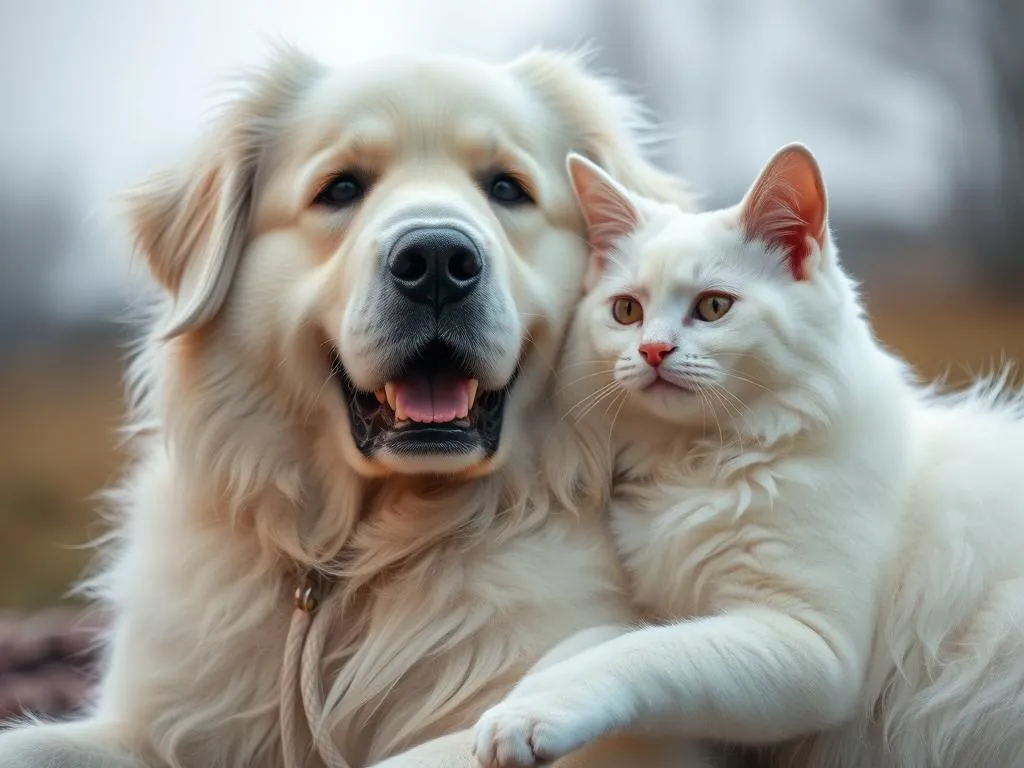
Introduction
The Great Pyrenees, known for their majestic appearance and gentle temperament, has long been a favorite among dog lovers. With their fluffy white coats and serene demeanor, these dogs are often seen as gentle giants. However, if you’re a cat owner or considering bringing a Great Pyrenees into a home with a feline friend, you might wonder: are Great Pyrenees good with cats? Understanding the compatibility between different pet species is crucial for a harmonious household. This article will delve into the interactions between Great Pyrenees and cats, exploring their temperament, training approaches, and potential challenges.
Understanding the Great Pyrenees
Breed Characteristics
The Great Pyrenees is a large breed, typically weighing between 85 to 115 pounds, and standing about 25 to 32 inches tall at the shoulder. Their thick, double coat helps them withstand harsh weather, making them well-suited for mountainous regions. The breed is known for its calm yet alert demeanor, characterized by loyalty and affectionate behavior towards family members.
In terms of personality, Great Pyrenees dogs are gentle, patient, and often playful. They possess a protective instinct, which can sometimes lead to a strong desire to guard their home and family. While they may be reserved around strangers, their affectionate nature shines through with loved ones.
Historical Background
Originally bred in the Pyrenees Mountains of France and Spain, the Great Pyrenees were primarily used as livestock guardians. Their role involved protecting sheep from predators, a task that required both bravery and intelligence. Over the years, these dogs have evolved from working animals to beloved family pets, adapting their guarding instincts to suit home environments. This background plays a crucial role in understanding how they might interact with other pets, particularly cats.
General Dog-Cat Relationships
Common Misconceptions
When it comes to dogs and cats, there are many stereotypes that can lead to misconceptions. One prevalent belief is that all dogs naturally chase cats. While some breeds have a stronger prey drive, this isn’t universally true. The idea that dogs and cats cannot coexist is largely based on exaggerated portrayals in media and anecdotal experiences.
Factors Influencing Compatibility
Compatibility between dogs and cats often depends on individual personalities rather than species-specific tendencies. Factors such as early socialization, training, and the dog’s overall demeanor significantly influence their interactions. For instance, a well-socialized Great Pyrenees may be more accepting of a cat than a poorly socialized one, regardless of breed.
Are Great Pyrenees Good with Cats?
Temperament Analysis
The temperament of the Great Pyrenees is a vital aspect to consider when evaluating their compatibility with cats. These dogs are generally known for their calm and composed nature, which can make them suitable companions for cats. Their protective instincts, however, can lead to complex interactions. While their guarding behavior is typically directed towards larger threats, a Great Pyrenees might view a cat as a smaller animal that needs protection—or, conversely, as something to investigate or chase.
Socialization Tips
To promote a peaceful coexistence, early exposure to cats is key. Introducing a Great Pyrenees puppy to a cat during their formative months can foster a sense of familiarity and acceptance. Gradual introductions are essential; this means allowing the dog and cat to observe each other from a distance before initiating closer interactions. Monitoring their initial meetings and rewarding calm behavior can set a positive tone for their relationship.
Case Studies and Anecdotes
Many Great Pyrenees owners report harmonious relationships between their dogs and cats. For instance, a family with both a Great Pyrenees and a tabby cat shared their experience of a gradual introduction process. Initially, the dog was curious and focused on the cat, but with proper supervision and positive reinforcement, they soon became inseparable companions. However, it’s important to note that every dog’s personality varies; some Great Pyrenees may take longer to adjust or may not be as tolerant of cats, highlighting the importance of individual assessments.
Training Great Pyrenees for Cat Compatibility
Basic Training Techniques
Training is a fundamental aspect of ensuring a Great Pyrenees can coexist peacefully with a cat. Basic commands such as “sit,” “stay,” and “leave it” can be invaluable in redirecting a dog’s attention away from a cat when necessary. Consistent obedience training lays the groundwork for a well-behaved pet.
Specific Strategies for Cat Integration
Integrating a Great Pyrenees with a cat involves more than just basic commands. Introducing scents and sounds unique to the cat can help ease the dog’s curiosity. For example, allowing the dog to sniff the cat’s bedding or toys before the initial meeting can create a sense of familiarity. Controlled meetings in a neutral space, where both animals feel safe, also promote positive interactions. Always supervise these encounters and reward calm behavior with treats and praise.
Potential Challenges
Behavioral Issues
Despite their generally gentle nature, Great Pyrenees may exhibit certain behavioral challenges when interacting with cats. Their instinctual prey drive can lead to chasing behaviors, especially if the cat runs or displays anxious behaviors. Signs of aggression or anxiety, such as growling or barking, should be addressed immediately through training and behavior modification techniques.
Environmental Factors
The living environment can also impact the dynamic between a Great Pyrenees and a cat. In multi-pet households, managing interactions becomes crucial. Providing separate spaces for each pet can help minimize conflict. Additionally, ensuring that the cat has high perches or safe areas to retreat to can help them feel secure in a shared living space.
Conclusion
In summary, the question of whether Great Pyrenees are good with cats can be answered with a nuanced understanding of both species. While Great Pyrenees possess a gentle temperament that can be conducive to peaceful cohabitation with cats, individual personalities, early socialization, and training play critical roles in shaping their interactions. For prospective pet owners, this means being proactive about training and socialization, recognizing potential challenges, and fostering an environment where both pets can thrive. Responsible pet ownership and continuous education about both species will help ensure a harmonious household.
Frequently Asked Questions (FAQs)
What should I do if my Great Pyrenees shows aggression towards my cat?
If your Great Pyrenees displays aggression towards your cat, it’s crucial to address the behavior immediately. Consider consulting with a professional dog trainer or animal behaviorist who can provide guidance on modifying this behavior through training techniques and behavior management.
Can Great Pyrenees and cats live together peacefully?
Yes, many Great Pyrenees can live peacefully with cats, especially if they are socialized together from a young age. The key is to ensure gradual introductions and positive reinforcement for calm behavior.
What age should I start socializing my Great Pyrenees with cats?
Socialization should begin early, ideally when your Great Pyrenees is a puppy, around 8 to 12 weeks of age. Early exposure to various animals, including cats, sets the stage for positive interactions later in life.
Are there specific cat breeds that get along better with Great Pyrenees?
While individual personalities vary, some cat breeds known for their sociable and dog-friendly nature include Ragdolls, Maine Coons, and Burmese. However, always consider the specific temperament of your cat alongside the dog’s behavior.
References
- American Kennel Club (AKC) – Great Pyrenees Breed Information
- Association of Professional Dog Trainers (APDT) – Dog and Cat Behavior
- The Humane Society of the United States – Tips for Introducing Dogs and Cats
This comprehensive exploration aims to provide valuable insights into the compatibility of Great Pyrenees with cats, ensuring that pet owners are well-equipped to foster a peaceful and loving environment for both animals.






